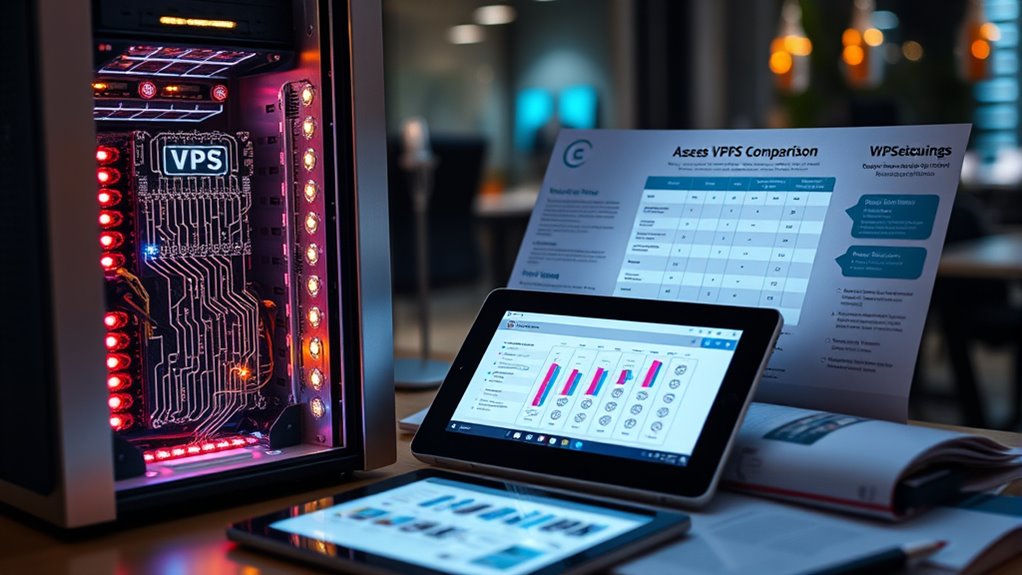To assess VPS features beyond discounts, focus on hardware quality, like CPU performance and RAM capacity, which directly impact speed and reliability. Don’t overlook additional offerings such as control panels, security features, and scalability options that support growth. Evaluate reliability metrics like uptime and disk I/O, and consider cost-effectiveness over time with total ownership costs. Exploring these aspects will help you find true value, ensuring your investment meets your needs efficiently. Keep exploring to learn more.
Key Takeaways
- Evaluate hardware specifications such as CPU performance, RAM, and storage speed to ensure they meet your workload needs.
- Consider included features like security, backups, management tools, and scalability options, which add long-term value.
- Assess the provider’s reliability, support quality, and service hours to minimize downtime and administrative overhead.
- Analyze total ownership costs, including maintenance, setup fees, and potential future upgrades, beyond initial discounts.
- Prioritize service quality and feature richness over promotional discounts to achieve sustainable, efficient hosting solutions.
Evaluating Hardware and Resource Allocation

When evaluating hardware and resource allocation in VPS plans, it’s essential to look beyond the price and consider how the underlying components impact performance. CPU architecture plays a vital role; newer models like AMD EPYC deliver significant performance boosts over older Intel Skylake chips, especially for multi-threaded tasks. The CPU model and generation directly influence raw processing power and single-threaded speeds, which matter for many workloads. Upgrades in CPU hardware often translate into measurable improvements in benchmarks like Sysbench or Geekbench. The CPU architecture can determine the efficiency and power consumption of the processor, impacting overall server performance and cost-effectiveness. Modern CPU architectures, for example, introduce features that improve both speed and energy efficiency, which can lead to cost savings over time. RAM allocation is equally important—more memory allows better handling of concurrent processes and caching, enhancing responsiveness. However, ensure your RAM matches your workload needs, avoiding over-provisioning. Overall, understanding the quality and generation of CPU and memory helps you assess VPS value accurately.
Analyzing Additional Features and Service Offerings

Analyzing additional features and service offerings is essential to determining the true value of a VPS plan. Control panels like DirectAdmin, Webuzo, Vepp, and Runcloud simplify management with features such as multi-PHP support, one-click app installs, SSL management, backups, and security tools like firewalls and IP blocking. Managed services, including OS updates, security patching, and 24/7 support, reduce your workload and improve uptime. Additionally, security features such as DDoS protection, resource isolation, and compliance certifications enhance safety and meet regulatory needs. Scalability options enable quick resource upgrades, flexible bandwidth, and easy application deployment, supporting growth without significant downtime. security features such as DDoS protection, resource isolation, and compliance certifications enhance safety and meet regulatory needs. Cookies play a vital role in enhancing user experience and providing analytics for site improvement. Moreover, hosting hours can vary significantly by provider, impacting your ability to receive support and manage your services promptly.
Considering Performance and Reliability Metrics

Evaluating performance and reliability metrics is vital to choosing the right VPS, as these factors directly impact your application’s speed and stability. CPU performance indicators like Geekbench scores, clock speed, and core count reveal how well the VPS can handle compute-intensive tasks. Load average helps you gauge CPU demand during peak times, preventing bottlenecks. Disk I/O metrics, such as IOPS and disk bandwidth, determine data transfer speed critical for database-heavy or storage-intensive applications. Network bandwidth and latency directly affect responsiveness, especially for real-time services. Memory stats, including available RAM and swap usage, show if the VPS can sustain workloads without crashing or slowing down. Additionally, understanding family dynamics can give you insights into the stability and support structure behind a VPS provider. Monitoring tools enable ongoing assessment of these metrics, ensuring you select a VPS that consistently delivers reliable, high-performance operation. Moreover, assessing long-term reliability through historical uptime data can help anticipate future performance stability. Incorporating performance benchmarks can further assist in comparing VPS options and selecting a solution that best fits your needs.
Assessing Scalability and Flexibility Options

Understanding how your VPS can grow to meet increasing demands is key to making a smart hosting choice. Vertical scaling lets you add CPU, RAM, or storage to a single VPS, often with just a few clicks and minimal downtime. This flexibility is ideal if your workload grows steadily, and you need consistent resources on one server. Keep in mind, there’s usually a cap based on the physical or cloud infrastructure, like up to 24 CPU cores or 64GB RAM. Horizontal scaling involves adding more VPS instances, distributing traffic, and improving fault tolerance. It requires load balancers and extra setup but offers better redundancy. Both options let you customize resources, supporting incremental growth without overpaying or sacrificing performance, making your hosting adaptable to changing needs. Resource allocation plays a crucial role in ensuring your VPS can scale effectively and meet future demands, especially when considering scalability features that allow for seamless expansion. Additionally, understanding performance limits helps you plan for growth without unexpected bottlenecks.
Weighing Cost-Benefit and Total Ownership Value

When choosing a VPS, balancing the initial costs against long-term benefits is essential to guarantee you’re getting the best value. Conduct a thorough cost-benefit analysis by comparing savings of up to 70% over dedicated servers with performance needs. Remember, pay-as-you-go models let you pay only for resources used, but watch out for setup fees, backup charges, and bandwidth overage costs that can increase your total expenses. Evaluate the performance consistency and flexibility of upgrades, as seamless scaling boosts long-term ROI. Consider Total Cost of Ownership (TCO), which includes direct costs like infrastructure and indirect costs such as maintenance and administrative overhead. Monitoring resource utilization helps avoid underused capacity, preventing wasted spending. Additionally, understanding the effectiveness of eye patches can serve as a reminder that focusing on the quality of components and their proven benefits ensures you receive genuine value beyond just the sticker price. Implementing predictive analytics for small business can further optimize operational efficiency and resource allocation. Incorporating home organization techniques can streamline your operations and reduce unnecessary expenses, ultimately enhancing your overall investment. Moreover, paying attention to the aesthetic and design elements of your infrastructure can improve user experience and operational efficiency.
Frequently Asked Questions
How Do Hidden Fees Impact the True Cost of VPS Hosting?
Hidden fees considerably impact your true VPS hosting costs by adding unexpected expenses beyond the initial price. You might pay more for backups, security features, bandwidth overages, or dedicated IPs, which can double or triple your bill. These costs can catch you off guard if you don’t review the fine print or choose transparent plans, making it essential to budget for all potential charges to avoid surprises.
What Are the Risks of Shared CPU Resources in VPS Plans?
Are you aware of the risks when sharing CPU resources in VPS plans? Shared CPUs can cause performance bottlenecks, leading to slow response times and inconsistent speeds during high traffic. They also increase security vulnerabilities, like side-channel attacks, and can suffer from resource contention, affecting reliability. Without dedicated cores, you have limited control over performance, making it harder to guarantee your applications run smoothly and securely.
How Reliable Are Customer Support Options Across Different Providers?
Customer support reliability varies among VPS providers. GreenGeeks offers 24/7 support with rapid responses, ensuring you’re never left waiting. Hostinger provides solid support but relies more on AI assistance and limited live chat, which might not be ideal for complex issues. For dependable help, choose providers like GreenGeeks or HostGator with managed plans, proactive monitoring, and multiple contact channels, so you’re covered whenever technical problems arise.
Do Managed VPS Plans Include Automatic Backups and Security Updates?
Yes, managed VPS plans include automatic backups and security updates. You benefit from scheduled daily backups, often with options to customize retention periods and storage. Security updates, including OS patches and critical system fixes, are typically handled automatically by the provider, reducing your administrative burden. These features help safeguard your data and keep your server secure without requiring your constant intervention, ensuring smoother, more reliable hosting.
How Do Egress and Data Transfer Costs Affect Overall Hosting Expenses?
Egress and data transfer costs can double your hosting expenses if you’re not careful. Did you know that outbound data transfer often costs between $0.01 and $0.12 per GB? When you’re running data-heavy apps, these charges add up fast. To save, use CDNs, compress data, and choose providers with generous free tiers. Managing your data flow is essential to keeping your overall hosting costs predictable and affordable.
Conclusion
Ultimately, understanding the true value of a VPS goes beyond just the sticker price or discounts. As you weigh hardware, features, performance, and scalability, remember that the real question isn’t just what’s on paper—but what will truly serve your needs in the long run. Don’t overlook the hidden factors that could make or break your decision. Stay vigilant—because sometimes, what seems affordable today might cost you more tomorrow.









